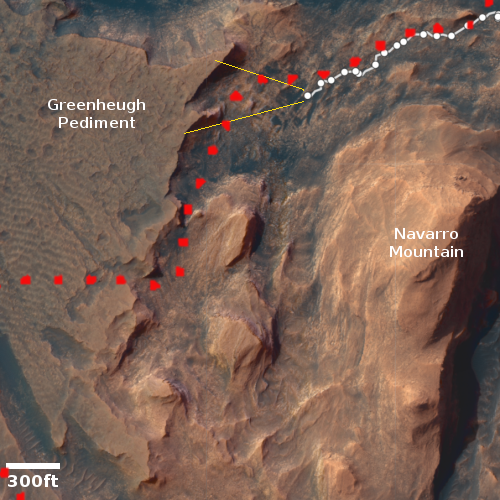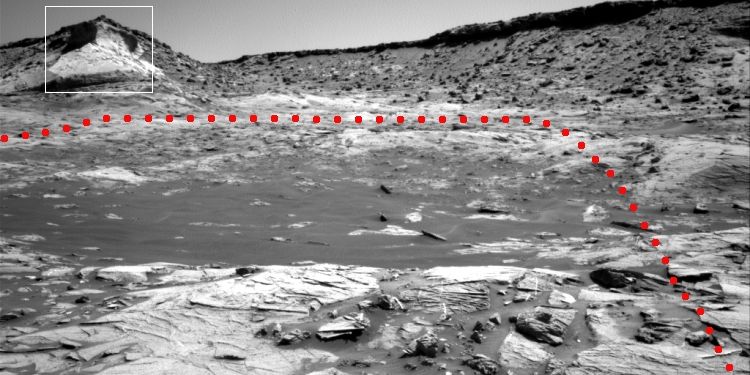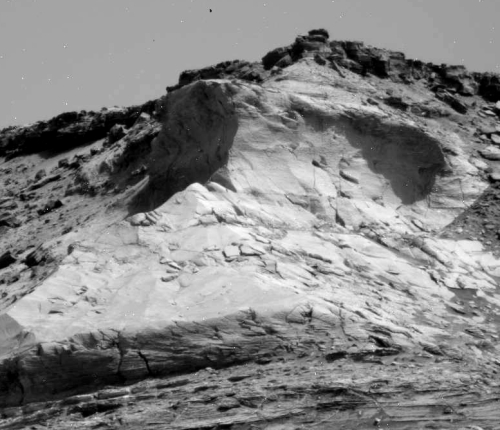Curiosity’s coming mountainous target

Click for interactive map.
Cool image time! The photo above, taken on August 22, 2021 by Curiosity’s left navigation camera and reduced to post here, looks ahead at the rover’s upcoming mountainous goals. The overview map to the right shows the area covered by this image by the yellow lines. The dotted red line indicates the rover’s original planned route, with the white dotted line its actual path of travel.
The cliff ahead is about 400-500 feet away. The top of this cliff is the Greenheugh Pediment, its blocky top geological layer visible as the dark cap at the top of the cliff face. Back in March 2020 Curiosity had climbed up to view across this pediment, from a point to the northwest and off the overview map to the left. (Go to this link to see what the view was like from there.) Since then the science team has had the rover travel quite a distance, to circle around to now approach the pediment from the east.
The white box marks the area covered by a close-up high resolution mast camera image, shown below.
The photo has been cropped, reduced, and enhanced by me. This cliff face, which I estimate is about 100 feet high, is without doubt to my mind the most spectacular single rock outcrop yet seen on any world that humans have yet visited. If all goes as planned, the rover will work its way along the base, probably getting as close as it can safely.
The cliff face looks like sometime in the past a giant used a hammer and chisel to chop off a big piece. Did an impact cause this? The overview map shows no craterlike impact features at the base of this cliff, making this explanation unlikely. Either the original crater occurred so long ago later geological and climate activity has wiped away all obvious evidence of it, or this cliff face was carved by other processes.
Ice flows? Running water? I am sure the rover’s science team is quite eager to find out.
What also makes this particular outcrop especially different is its massiveness. So far all other cliffs that Curiosity has gotten close to have been made up of many thin layers. This outcrop seems from this distance one massive piece, suggesting it represents a single event layer. Only a closer look will tell us whether it, like everything else Curiosity has so far seen, has many sub-layers within the major structure.
On Christmas Eve 1968 three Americans became the first humans to visit another world. What they did to celebrate was unexpected and profound, and will be remembered throughout all human history. Genesis: the Story of Apollo 8, Robert Zimmerman's classic history of humanity's first journey to another world, tells that story, and it is now available as both an ebook and an audiobook, both with a foreword by Valerie Anders and a new introduction by Robert Zimmerman.
The print edition can be purchased at Amazon or from any other book seller. If you want an autographed copy the price is $60 for the hardback and $45 for the paperback, plus $8 shipping for each. Go here for purchasing details. The ebook is available everywhere for $5.99 (before discount) at amazon, or direct from my ebook publisher, ebookit. If you buy it from ebookit you don't support the big tech companies and the author gets a bigger cut much sooner.
The audiobook is also available at all these vendors, and is also free with a 30-day trial membership to Audible.
"Not simply about one mission, [Genesis] is also the history of America's quest for the moon... Zimmerman has done a masterful job of tying disparate events together into a solid account of one of America's greatest human triumphs."--San Antonio Express-News



